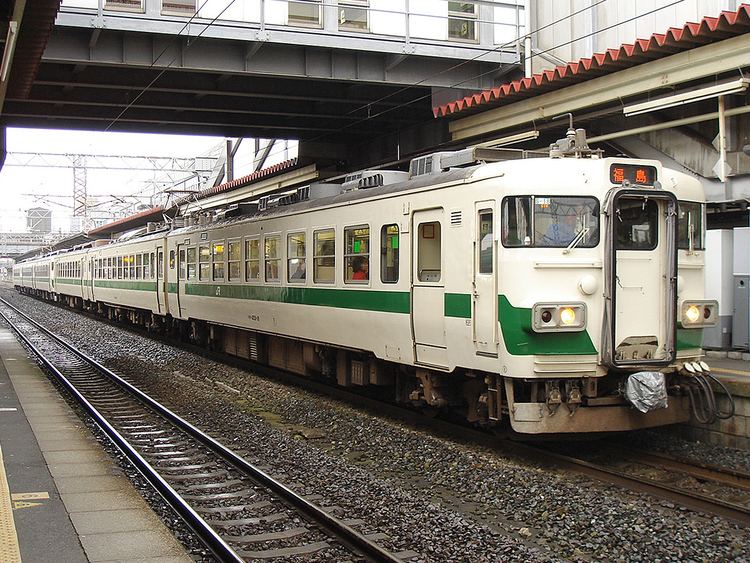Constructed 1965-1971 Number preserved 3 vehicles | Number in service none Car body construction Steel | |
 | ||
In service October 1965 – March 2015 Operator(s) JNR (1965–1987)JR East (1987–2008)JR Kyushu (1987–2010)JR-West (1987–2015) | ||
The 455 series (455系, 455-kei) is a Japanese dual-voltage (1,500 V DC and 20 kV AC 50 Hz) electric multiple unit (EMU) train type introduced by Japanese National Railways (JNR) on express services in 1965 and later operated by East Japan Railway Company (JR East), West Japan Railway Company (JR-West), and Kyushu Railway Company (JR Kyushu).
Contents
- Design
- Variants
- 455 0 series
- 455 200 series
- 455 300 series
- 455 400 series
- 455 500 series
- 455 600 series
- 455 700 series
- Formations
- 413 series sets B04 and B11
- 475 series sets A05 and A26
- Past formations
- Key
- Interior
- History
- Preserved examples
- References
As of October 2013, JR-West was the only operator still running 455 series cars, 16 KuHa 455 driving cars included in 413 and 475 series 3-car sets. JR East withdrew the last of its fleet in 2008, and JR Kyushu withdrew its last remaining cars in 2010.
Design
Intended for use in the Tohoku region, the basic design and appearance was identical to the 475 series dual-voltage (1,500 V DC and 20 kV AC 60 Hz) EMUs introduced around the same time in Kyushu, and similar to the earlier 453 and 473 series EMUs. The first units built were not equipped with air-conditioning, except for the SaRo 455 "Green" (first class) cars.
Variants
455-0 series
These were the 455 series cars built from new between 1965 and 1971.
With the reduction in express services and gradual reassignment of 455 series sets to local services, a number of cab cars were subsequently rebuilt from intermediate cars or other EMU types from 1975 to allow shorter sets to be formed.
455-200 series
455-300 series
455-400 series
455-500 series
455-600 series
455-700 series
Formations
As of 1 October 2013, JR-West operates 16 KuHa 455 cars (including two KuHa 455-700 cars), included in mixed 413/455 and 475/455 series three-car sets based at Kanazawa Depot and used on the Hokuriku Main Line. They are formed as shown below.
413 series sets B04 and B11
475 series sets A05 and A26
Past formations
A typical formation for a combined Bandai (455 series, cars 1 to 6, Ueno - Kitakata) and Iwate (451/453 series, cars 7 to 13, Ueno - Morioka) service as of March 1972 is shown below.
JR East 3-car sets (S2 to S51) based at Sendai Depot and used in the Tohoku region until their withdrawal in 2008 were formed as shown below.
One JR East 3-car set, S40, based at Sendai Depot, was modified in 1999 with a KuRoHa 455 car at the north end including three rows of "Green" car (first class) accommodation arranged 2+2 abreast.
Key
Interior
Designed for use on express services, passenger accommodation consisted of fixed 4-person seating bays.
History
The 455 series trains were first introduced from the start of the 1 October 1965 revised timetable, operating on Iwate and Kitakami express services between Ueno in Tokyo and Morioka in the north-east of Japan, and also on Matsushima services between Ueno and Sendai.
From 1 July 1967, 455 series trains were introduced on new Bandai express services operating on the Banetsu West Line. From 1 October 1968, with the completion of AC electrification of the route between Fukushima and Sendai via the Ou Main Line and Senzan Line, 455 series trains were introduced on Giō services operating between Ueno and Yamagata.
From the late 1960s, JNR was beginning to install air-conditioning on its trains, and 455 series cars built from June 1968 were designed to allow air-conditioning to be added easily at a later date. Air-conditioning was subsequently retrofitted between 1969 and 1975.
With the opening of the Tohoku Shinkansen, the number of express services in the region were cut back from the start of the 15 November 1982 timetable revision, and discontinued by March 1985. JR East 455 series sets were reassigned to local services, and withdrawn by 2008.
Preserved examples
As of 2012, three 455 series EMU cars are preserved, all at the Railway Museum in Saitama Prefecture.
